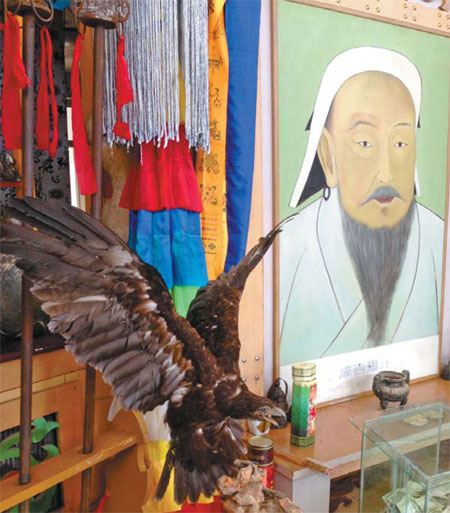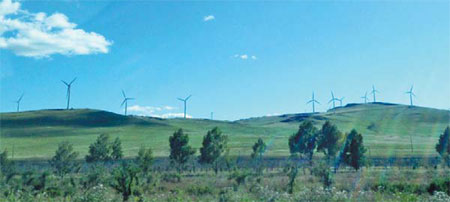Proud children of Genghis Khan
By Cang Lide (China Daily)
Updated: 2013-09-22
|
Genghis Khan's portrait is displayed at the Hohnur tourist center. Photos by Cang Lide / China Daily |
|
Sustainable energy is part of the grassland's natural resources. |
Hulunbuir is China's largest grassland and a place where ethnic Mongolians' nomadic herding lifestyles have continued for millennia. Cang Lide examines changing economic landscape and psychographics.
We could feel his presence the moment we touched down in the Inner Mongolia autonomous region. Genghis Khan, the father of the Mongolian people, is still very much alive in the hearts of his descendants even though he died in 1227. The Mongolians believe no one else can be their hero.
Suld, the green-eyed guide we met at the Genghis Khan Mausoleum in western Inner Mongolia, is a recent graduate from a normal university in Hohhot, the autonomous region's capital. He decided to work here instead of returning home, which is thousands of kilometers away in the northeast.
He's named after the divine spear of Genghis Khan, a symbol that stands proudly erect in the mausoleum grounds.
The Darkhad clan is the appointed guardian of the Khan's memorial. Its members have faithfully guarded the mausoleum for eight centuries, generation after generation.
In the main palace, as we watched venerators kneeling in front of the silver sarcophagus to pay their respects to the Great Khan, Suld tells me that, as an ethic Mongolian, he loves his job because he takes pride in showing his heritage to visitors.
Two days later, we are far away in a yurt on the grassland some 300 kilometers east of the mausoleum. The yurt resort is called the Sacred Place of Mongols, but other than grasslands and hills stretching to the horizon, there were no historic relics in sight.

Why is it so sacred then?
"This is the land passed down by our ancestors," our young Mongolian guide Huqing says.
"The region here is under the United Banner of Darhan and Maoming'an, named after two military camps set up by Genghis Khan on his way to conquer the West."
But the highlight of our three-city trip was definitely the Hulunbuir grasslands, a two-and-a-half-hour flight from Hohhot. It is here that the heartbeat of Genghis Khan's descendants beats the strongest.
Hulunbuir is one of the largest grasslands on Earth. Bordering Russia to the north and west, and Mongolia to the south and west, it is under the administration of the prefecture-level city of Hulunbuir, which covers 253,000 square kilometers, including cities, grasslands, wetlands, rivers, lakes, forests and plains.
A large part of the 84,000 square kilometers of grasslands has maintained its original condition with a hundred or so species of quality grazing grass.
Hulunbuir, or Hulun Buir in Mongolian, was named after the handsome Hulun and beautiful Buir, two young star-crossed Mongolian lovers forced to separate. They became two huge lakes: Hulun and Buir.
Many historians and anthropologists believe the Hulunbuir area is the birthplace of the Mongolian people. At the Zhalainur Museum near the border town Manzhouli, historical records and archeological discoveries show Genghis Khan's ancestor moved the clan south to the grasslands from the mountains in the north around AD 800.
Born as Temujin, the Great Khan won crucial battles against rival nomadic tribes and eventually unified the Mongol plateau in 1208. He was proclaimed "Genghis Khan".
Soon, he led his formidable cavalry forces across the West, conquering most of Eurasia and became the founding father of the Mongol Empire, by some measures the largest contiguous empire in history.
Although the 230,000 ethnic Mongolians are only a minority in Hulunbuir today, most of them live on the grasslands with their livestock, maintaining a lifestyle much like their ancestors led centuries ago.
Animal husbandry still plays a major role in the total GDP, which is otherwise primarily powered by the agriculture, forestry and fishery sectors.
About 18 million heads of livestock roam the grasslands, the latest local government figures show. About 70 percent are sheep - a main source of nomadic Mongolians' meat and income. Beef, mutton and dairy products are shipped to other cities in China.
Signs of modern life can also be found.
On our way to the grasslands from Manzhouli, we saw towering wind turbines on the hills not too far away from the smooth, well-paved roads. Combine-harvesters were busy cutting grass, and trucks carrying large stacks of hay rushed past us.
Millions of tons of grass are harvested each year, some of which are exported to Japan and the Republic of Korea for their cattle.
"This year, the weather has been so good that there have been two grass harvests," Sonia Bao, the Mongolian events manager of the Manzhouli Shangri-La Hotel says, as she guides us through the grasslands.
What touches my heart most is ethnic Mongolians' love of their homeland.
Sonia says she did not hesitate to move back to Hulunbuir even though she had a good job in a large city outside Inner Mongolia. The reason is simple, she says.
"My family name - Bao in Han Chinese (Mandarin) - is actually derived from Genghis Khan's clan," she says proudly.
She grew up in Beijing with her grandfather. When her grandfather retired, he decided to return home, where he died a few years ago. At his funeral, Sonia sang Gadameilin for her grandfather. It was his favorite folksong and extols a Mongolian hero who gave his life in the fight for his fellow Mongolians' land rights.
Some of her relatives have moved elsewhere, she says. But even so, the strong attachment to the grasslands draws them back.
"They say, if they die one day, they would still want to be buried on Hulunbuir because it's the land their spirits can never leave."
That's the local sentiment.
Hulunbuir's magnificent grasslands are still the abode of Genghis Khan's legacy and a well from which ethnic Mongolians sprang.
Contact the writer at canglide@chinadaily.com.cn.
(China Daily 09/22/2013 page3)

High-speed train debuts in Inner Mongolia
A bullet train departed Hohhot East Railway Station for Ulanqab marking the start of high-speed rail services using Inner Mongolia’s first newly-laid high-speed railway on Aug 3.


